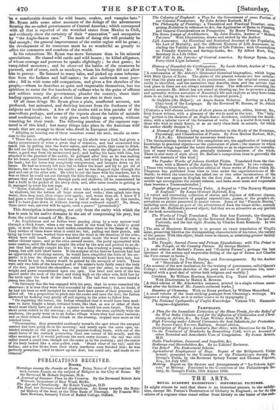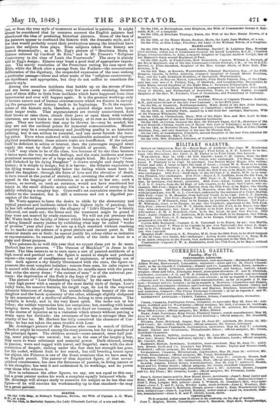THE ARTS, ROYAL ACADEMY EXHIBITION: HISTORICAL PICTURES. IT might almost
be said that there is no historical picture in the exhibi- tion, except Mr. Patten's Destruction of Idolatry in England; so far do the others of a cognate class stand either from history in the letter of the..tiub- ;est, or from the true style of treatment as historical in painting. It might 'almost be considered that by common consent the English painters had abandoned the idea of producing historical pictures. Some of the best of the painters appear to confound the historic with the dramatic style, and a few that would probably count their productions among the historical have drawn the subjects from plays. Even subjects taken from history are treated dramatically; as in Mr. Egg's picture of " Henrietta Maria in distress relieved by Cardinal de Retz," and in Mr. Elmore's "Religious Controversy in the time of Louis the Fourteenth." The story is plainly told imEgg's design; Elmore may boast a good deal of appropriate expres- sion. The sturdy resolution of the Protestant resting his case upon the Bible, while the Monk cites a passage from the Fathers-the concentrated deliberation of the dignitary, the suspended expression of the man seeking &particular passage-these and other traits of the "religious controversy," are significant and appropriate, but they do not suffice to constitute the historic style.
Among the countless incidents that bubble up on the stream of time and are borne away to oblivion, very few are worth retaining, because most of them differ so little from incidents which have happened from time immemorial and ever will happen again. It is the greatest workings only of human nature and of human circumstances which we discern in survey- ing the perspective of history back to its beginnings. To fit the require- ments of the historic style, therefore, a painted design must turn upon those larger traits. That argumentators are sternly unconvinced, knit their brows or raise them, clench their jaws or open them with voluble utterance, are not traits to record in history, or to rest an historic design upon. They are incidents that may be thrown in-may be needed, but they are not the cardinal points for immortal commemoration. Minute propriety may be a complementary and justifying quality in an historical painting, but it can seldom be essential, and can never furnish the turn- ing-point. Even when endowed with considerable animation and vigorous physical manifestation, these minute traits are insufficient. If the sub,,ect itself be deficient in action or interest, then the personages engaged must supply the want by their dignity or breadth of passion. Mr. Patten's " Coifi " may claim to be of the class, less because of its size than because it turns upon the very broadest feelings, and the main incidents and more prominent accessories are of a large and simple kind. Mr. Lucy's "Crom- well Rebuked by his dying Daughter" is drawn straight and simply from history; it is simple in design; but it is barren: the didactic expression of the dying woman is lamentably below the feeling which must have in- spired the daughter, through the force of love and the elevation of death, to turn round at the portal of eternity, and, reversing the order of nature, appeal in the language of exhortation as a mother to her son : such a woman, so moved, on such an occasion, would not have manifested her intent in the small didactic action suited to a mother of' every-day life mildly rebuking a naughty boy. Cromwell's set convulsive remorse is less inferior to the occasion, but is still a common and not a dignified per- ception of the feeling.
Mr. Watts appears to have the desire to abide by the elementary and typical passions and incidents suited to the highest style of painting; but he has left school prematurely: the allegory of "Life's Illusions" is faintly indicated, not made out; the forms and the treatment might be grand if they were not marred by crude execution. We will not yet presume that Mr. Watts lacks the faculty of labour which belongs to true genius; but he is doing himself scanty justice by exhibiting what may be called "works of promise "year after year: he sets up a high standard without reaching it; he marks out the pattern of a great picture and cannot paint it. His essential details are at fault: he cannot justify his colour either as imitative or representative; he cannot justify the action of the limbs as bent to a plain and direct purpose.
Two painters do so well this year that we expect them yet to do more. Herbert has two pictures. "The Outcast of Mankind" is Jesus in the desert. The idea seems to us to turn upon a sort of painted antithesis of a high moral and poetical sort: the figure is seated in simple and profound repose-the repose of steadfastness not of supineness, of awaiting not of rest: dark against a sky faintly illuminated with the stars, the figure re- presents the most complete isolation: remote from man, its calm repose is in accord with the silence of the darkness, its steadfastness with the power that rules the starry dome: "the outcast of man" is of the universal pre- sence: the deprivation of the flesh is the hope of the spirit.
The picture of "Lear Disinheriting Cordelia," by the same hand, unites a very high power with a sample of the most faulty style of design. Lear's bulky form, his massive features, his turgid rage do not fit the wayward splenetic bitterness of dotage. The smooth fedingless beauty of the one daughter and the harsh symmetry of the other, although slightly disfigured by the mannerism of a medieval stiffness, belong to true expression. The Cordelia is lovely, and in the very finest spirit. She looks not at her father; she neither reproaches him nor complains; but, standing with hands hanging down clasped before her, her eyes fixed on vacancy, she submits to the decree of injustice as to a visitation which attests without putting a strain upon her fortitude: the sweetness of her face is stronger than the cruelty of her lot. Mr. Herbert has fully conceived the character of Cor- delia: he has not taken the same trouble with Lear.
Mr. Armitage's picture of the Princess who came in search of Gilbert a'Becket might be counted among the story pictures, but for the grandeur of the principal figure. The children around-some amazed, some half jest- ing, some pitying-are natural; but, as in the case of the laughieg boy, they seem to want substance and material power. Dark-skinned, strong in passion, worn and ragged with travel, self forgetful, stern with the slow conviction of despair, sinking under the fear that her strength has gone, her life ended, without fruit to her search, but still brooding intent upon her object, the Princess is one of the finest creations that we have seen by an English pencil. The painter of that dejected figure, of that unvan- quished countenance, has seen the fierceness of passion, in living nature or in his thoughts; has seen it and understood it, its workings, and its power over those who witness it.
Now in substance the other figures, we say, are not equal to this one: but a great painter makes his work a complete equally balanced Whole. If Mr. Armitage will always study to conceive his subject as he has that one figure-if he will execute his workmanship up to that standard-he may be a great painter.



























 Previous page
Previous page